Summary Statement for Professional Engineer Competency Elements
VerifiedAdded on 2023/06/15
|5
|1626
|230
AI Summary
This summary statement showcases how the competency elements of a Professional Engineer have been applied in various career episodes. It includes elements such as knowledge and skill base, engineering application ability, professional and personal attributes, and more. The summary also mentions the specific career episodes where each element has been addressed.
Contribute Materials
Your contribution can guide someone’s learning journey. Share your
documents today.
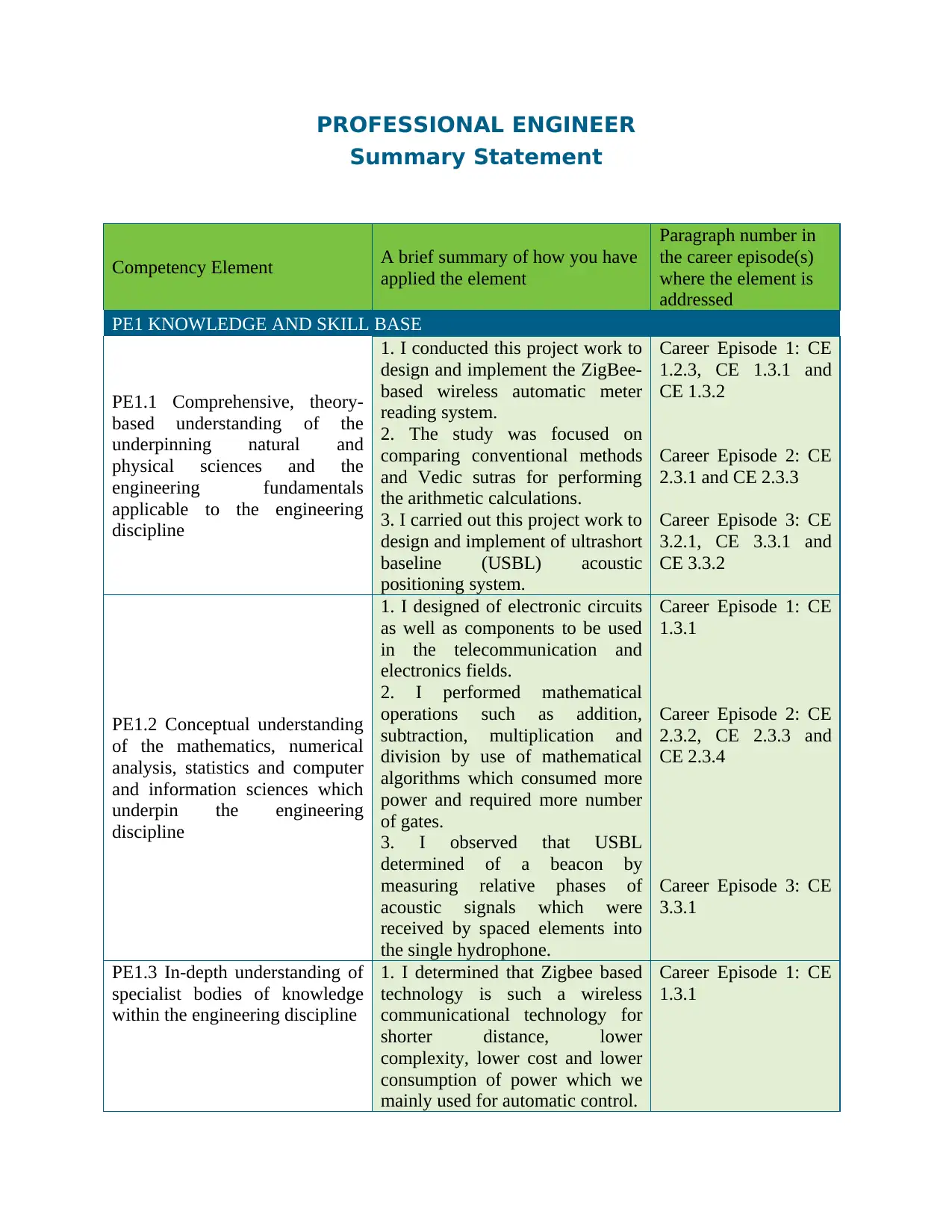
PROFESSIONAL ENGINEER
Summary Statement
Competency Element A brief summary of how you have
applied the element
Paragraph number in
the career episode(s)
where the element is
addressed
PE1 KNOWLEDGE AND SKILL BASE
PE1.1 Comprehensive, theory-
based understanding of the
underpinning natural and
physical sciences and the
engineering fundamentals
applicable to the engineering
discipline
1. I conducted this project work to
design and implement the ZigBee-
based wireless automatic meter
reading system.
2. The study was focused on
comparing conventional methods
and Vedic sutras for performing
the arithmetic calculations.
3. I carried out this project work to
design and implement of ultrashort
baseline (USBL) acoustic
positioning system.
Career Episode 1: CE
1.2.3, CE 1.3.1 and
CE 1.3.2
Career Episode 2: CE
2.3.1 and CE 2.3.3
Career Episode 3: CE
3.2.1, CE 3.3.1 and
CE 3.3.2
PE1.2 Conceptual understanding
of the mathematics, numerical
analysis, statistics and computer
and information sciences which
underpin the engineering
discipline
1. I designed of electronic circuits
as well as components to be used
in the telecommunication and
electronics fields.
2. I performed mathematical
operations such as addition,
subtraction, multiplication and
division by use of mathematical
algorithms which consumed more
power and required more number
of gates.
3. I observed that USBL
determined of a beacon by
measuring relative phases of
acoustic signals which were
received by spaced elements into
the single hydrophone.
Career Episode 1: CE
1.3.1
Career Episode 2: CE
2.3.2, CE 2.3.3 and
CE 2.3.4
Career Episode 3: CE
3.3.1
PE1.3 In-depth understanding of
specialist bodies of knowledge
within the engineering discipline
1. I determined that Zigbee based
technology is such a wireless
communicational technology for
shorter distance, lower
complexity, lower cost and lower
consumption of power which we
mainly used for automatic control.
Career Episode 1: CE
1.3.1
Summary Statement
Competency Element A brief summary of how you have
applied the element
Paragraph number in
the career episode(s)
where the element is
addressed
PE1 KNOWLEDGE AND SKILL BASE
PE1.1 Comprehensive, theory-
based understanding of the
underpinning natural and
physical sciences and the
engineering fundamentals
applicable to the engineering
discipline
1. I conducted this project work to
design and implement the ZigBee-
based wireless automatic meter
reading system.
2. The study was focused on
comparing conventional methods
and Vedic sutras for performing
the arithmetic calculations.
3. I carried out this project work to
design and implement of ultrashort
baseline (USBL) acoustic
positioning system.
Career Episode 1: CE
1.2.3, CE 1.3.1 and
CE 1.3.2
Career Episode 2: CE
2.3.1 and CE 2.3.3
Career Episode 3: CE
3.2.1, CE 3.3.1 and
CE 3.3.2
PE1.2 Conceptual understanding
of the mathematics, numerical
analysis, statistics and computer
and information sciences which
underpin the engineering
discipline
1. I designed of electronic circuits
as well as components to be used
in the telecommunication and
electronics fields.
2. I performed mathematical
operations such as addition,
subtraction, multiplication and
division by use of mathematical
algorithms which consumed more
power and required more number
of gates.
3. I observed that USBL
determined of a beacon by
measuring relative phases of
acoustic signals which were
received by spaced elements into
the single hydrophone.
Career Episode 1: CE
1.3.1
Career Episode 2: CE
2.3.2, CE 2.3.3 and
CE 2.3.4
Career Episode 3: CE
3.3.1
PE1.3 In-depth understanding of
specialist bodies of knowledge
within the engineering discipline
1. I determined that Zigbee based
technology is such a wireless
communicational technology for
shorter distance, lower
complexity, lower cost and lower
consumption of power which we
mainly used for automatic control.
Career Episode 1: CE
1.3.1
Secure Best Marks with AI Grader
Need help grading? Try our AI Grader for instant feedback on your assignments.
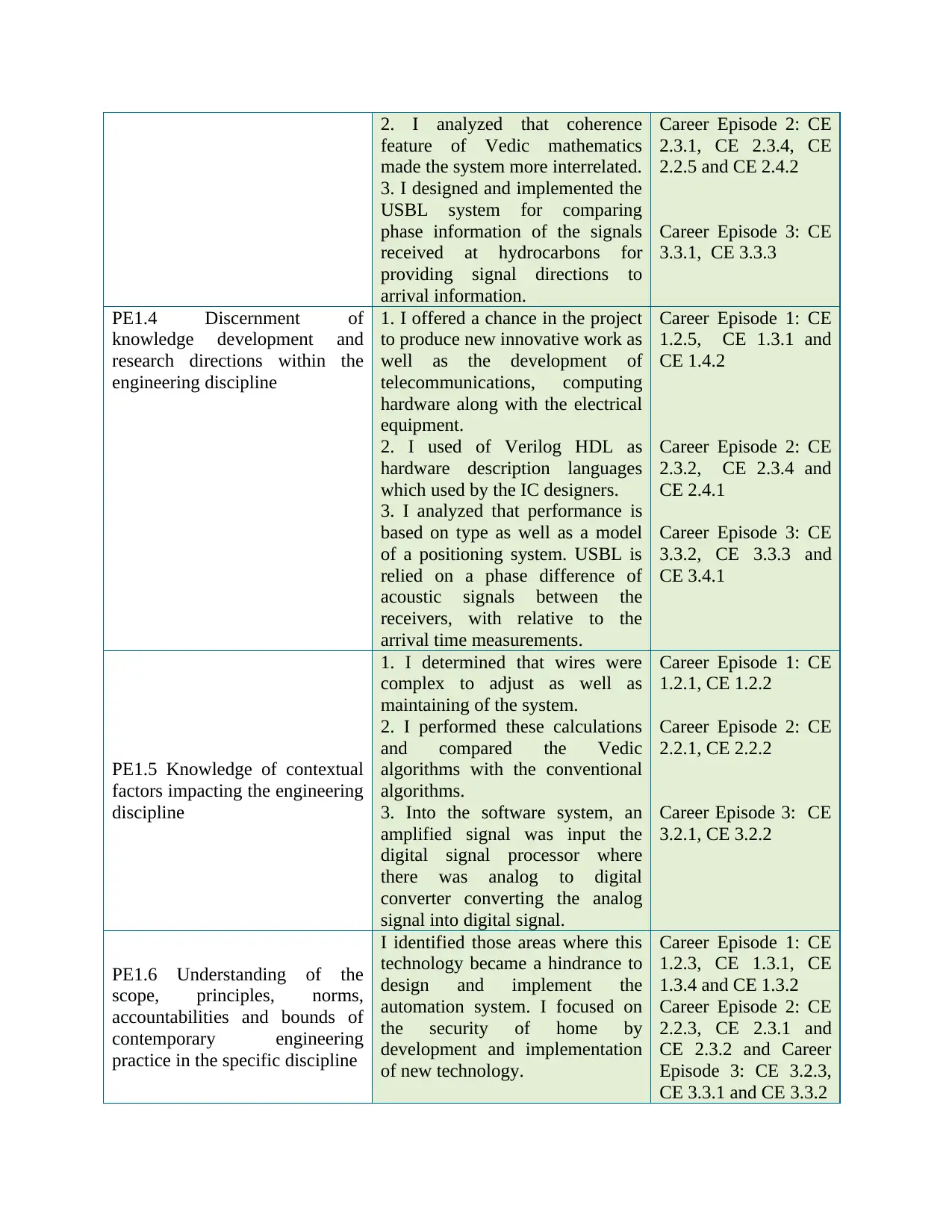
2. I analyzed that coherence
feature of Vedic mathematics
made the system more interrelated.
3. I designed and implemented the
USBL system for comparing
phase information of the signals
received at hydrocarbons for
providing signal directions to
arrival information.
Career Episode 2: CE
2.3.1, CE 2.3.4, CE
2.2.5 and CE 2.4.2
Career Episode 3: CE
3.3.1, CE 3.3.3
PE1.4 Discernment of
knowledge development and
research directions within the
engineering discipline
1. I offered a chance in the project
to produce new innovative work as
well as the development of
telecommunications, computing
hardware along with the electrical
equipment.
2. I used of Verilog HDL as
hardware description languages
which used by the IC designers.
3. I analyzed that performance is
based on type as well as a model
of a positioning system. USBL is
relied on a phase difference of
acoustic signals between the
receivers, with relative to the
arrival time measurements.
Career Episode 1: CE
1.2.5, CE 1.3.1 and
CE 1.4.2
Career Episode 2: CE
2.3.2, CE 2.3.4 and
CE 2.4.1
Career Episode 3: CE
3.3.2, CE 3.3.3 and
CE 3.4.1
PE1.5 Knowledge of contextual
factors impacting the engineering
discipline
1. I determined that wires were
complex to adjust as well as
maintaining of the system.
2. I performed these calculations
and compared the Vedic
algorithms with the conventional
algorithms.
3. Into the software system, an
amplified signal was input the
digital signal processor where
there was analog to digital
converter converting the analog
signal into digital signal.
Career Episode 1: CE
1.2.1, CE 1.2.2
Career Episode 2: CE
2.2.1, CE 2.2.2
Career Episode 3: CE
3.2.1, CE 3.2.2
PE1.6 Understanding of the
scope, principles, norms,
accountabilities and bounds of
contemporary engineering
practice in the specific discipline
I identified those areas where this
technology became a hindrance to
design and implement the
automation system. I focused on
the security of home by
development and implementation
of new technology.
Career Episode 1: CE
1.2.3, CE 1.3.1, CE
1.3.4 and CE 1.3.2
Career Episode 2: CE
2.2.3, CE 2.3.1 and
CE 2.3.2 and Career
Episode 3: CE 3.2.3,
CE 3.3.1 and CE 3.3.2
feature of Vedic mathematics
made the system more interrelated.
3. I designed and implemented the
USBL system for comparing
phase information of the signals
received at hydrocarbons for
providing signal directions to
arrival information.
Career Episode 2: CE
2.3.1, CE 2.3.4, CE
2.2.5 and CE 2.4.2
Career Episode 3: CE
3.3.1, CE 3.3.3
PE1.4 Discernment of
knowledge development and
research directions within the
engineering discipline
1. I offered a chance in the project
to produce new innovative work as
well as the development of
telecommunications, computing
hardware along with the electrical
equipment.
2. I used of Verilog HDL as
hardware description languages
which used by the IC designers.
3. I analyzed that performance is
based on type as well as a model
of a positioning system. USBL is
relied on a phase difference of
acoustic signals between the
receivers, with relative to the
arrival time measurements.
Career Episode 1: CE
1.2.5, CE 1.3.1 and
CE 1.4.2
Career Episode 2: CE
2.3.2, CE 2.3.4 and
CE 2.4.1
Career Episode 3: CE
3.3.2, CE 3.3.3 and
CE 3.4.1
PE1.5 Knowledge of contextual
factors impacting the engineering
discipline
1. I determined that wires were
complex to adjust as well as
maintaining of the system.
2. I performed these calculations
and compared the Vedic
algorithms with the conventional
algorithms.
3. Into the software system, an
amplified signal was input the
digital signal processor where
there was analog to digital
converter converting the analog
signal into digital signal.
Career Episode 1: CE
1.2.1, CE 1.2.2
Career Episode 2: CE
2.2.1, CE 2.2.2
Career Episode 3: CE
3.2.1, CE 3.2.2
PE1.6 Understanding of the
scope, principles, norms,
accountabilities and bounds of
contemporary engineering
practice in the specific discipline
I identified those areas where this
technology became a hindrance to
design and implement the
automation system. I focused on
the security of home by
development and implementation
of new technology.
Career Episode 1: CE
1.2.3, CE 1.3.1, CE
1.3.4 and CE 1.3.2
Career Episode 2: CE
2.2.3, CE 2.3.1 and
CE 2.3.2 and Career
Episode 3: CE 3.2.3,
CE 3.3.1 and CE 3.3.2
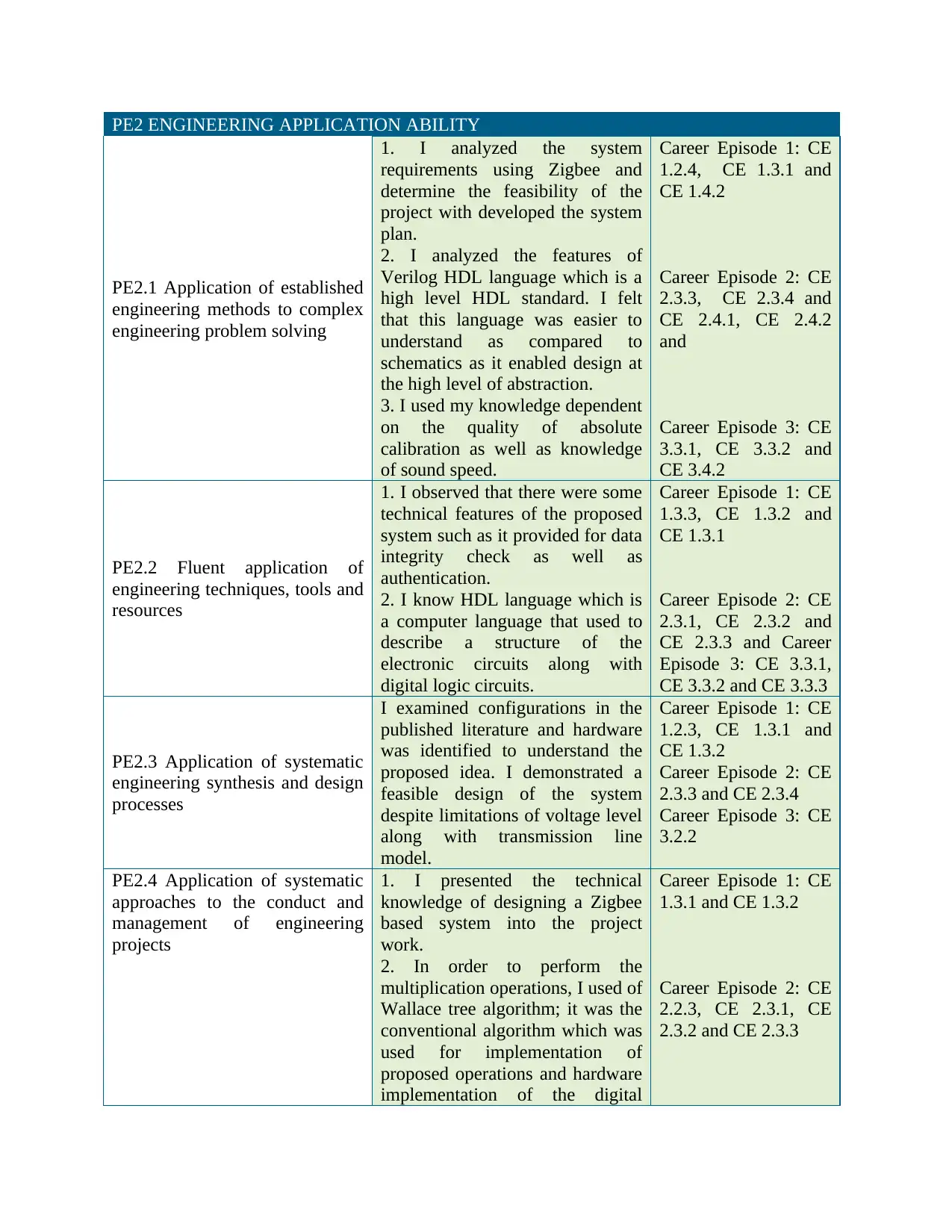
PE2 ENGINEERING APPLICATION ABILITY
PE2.1 Application of established
engineering methods to complex
engineering problem solving
1. I analyzed the system
requirements using Zigbee and
determine the feasibility of the
project with developed the system
plan.
2. I analyzed the features of
Verilog HDL language which is a
high level HDL standard. I felt
that this language was easier to
understand as compared to
schematics as it enabled design at
the high level of abstraction.
3. I used my knowledge dependent
on the quality of absolute
calibration as well as knowledge
of sound speed.
Career Episode 1: CE
1.2.4, CE 1.3.1 and
CE 1.4.2
Career Episode 2: CE
2.3.3, CE 2.3.4 and
CE 2.4.1, CE 2.4.2
and
Career Episode 3: CE
3.3.1, CE 3.3.2 and
CE 3.4.2
PE2.2 Fluent application of
engineering techniques, tools and
resources
1. I observed that there were some
technical features of the proposed
system such as it provided for data
integrity check as well as
authentication.
2. I know HDL language which is
a computer language that used to
describe a structure of the
electronic circuits along with
digital logic circuits.
Career Episode 1: CE
1.3.3, CE 1.3.2 and
CE 1.3.1
Career Episode 2: CE
2.3.1, CE 2.3.2 and
CE 2.3.3 and Career
Episode 3: CE 3.3.1,
CE 3.3.2 and CE 3.3.3
PE2.3 Application of systematic
engineering synthesis and design
processes
I examined configurations in the
published literature and hardware
was identified to understand the
proposed idea. I demonstrated a
feasible design of the system
despite limitations of voltage level
along with transmission line
model.
Career Episode 1: CE
1.2.3, CE 1.3.1 and
CE 1.3.2
Career Episode 2: CE
2.3.3 and CE 2.3.4
Career Episode 3: CE
3.2.2
PE2.4 Application of systematic
approaches to the conduct and
management of engineering
projects
1. I presented the technical
knowledge of designing a Zigbee
based system into the project
work.
2. In order to perform the
multiplication operations, I used of
Wallace tree algorithm; it was the
conventional algorithm which was
used for implementation of
proposed operations and hardware
implementation of the digital
Career Episode 1: CE
1.3.1 and CE 1.3.2
Career Episode 2: CE
2.2.3, CE 2.3.1, CE
2.3.2 and CE 2.3.3
PE2.1 Application of established
engineering methods to complex
engineering problem solving
1. I analyzed the system
requirements using Zigbee and
determine the feasibility of the
project with developed the system
plan.
2. I analyzed the features of
Verilog HDL language which is a
high level HDL standard. I felt
that this language was easier to
understand as compared to
schematics as it enabled design at
the high level of abstraction.
3. I used my knowledge dependent
on the quality of absolute
calibration as well as knowledge
of sound speed.
Career Episode 1: CE
1.2.4, CE 1.3.1 and
CE 1.4.2
Career Episode 2: CE
2.3.3, CE 2.3.4 and
CE 2.4.1, CE 2.4.2
and
Career Episode 3: CE
3.3.1, CE 3.3.2 and
CE 3.4.2
PE2.2 Fluent application of
engineering techniques, tools and
resources
1. I observed that there were some
technical features of the proposed
system such as it provided for data
integrity check as well as
authentication.
2. I know HDL language which is
a computer language that used to
describe a structure of the
electronic circuits along with
digital logic circuits.
Career Episode 1: CE
1.3.3, CE 1.3.2 and
CE 1.3.1
Career Episode 2: CE
2.3.1, CE 2.3.2 and
CE 2.3.3 and Career
Episode 3: CE 3.3.1,
CE 3.3.2 and CE 3.3.3
PE2.3 Application of systematic
engineering synthesis and design
processes
I examined configurations in the
published literature and hardware
was identified to understand the
proposed idea. I demonstrated a
feasible design of the system
despite limitations of voltage level
along with transmission line
model.
Career Episode 1: CE
1.2.3, CE 1.3.1 and
CE 1.3.2
Career Episode 2: CE
2.3.3 and CE 2.3.4
Career Episode 3: CE
3.2.2
PE2.4 Application of systematic
approaches to the conduct and
management of engineering
projects
1. I presented the technical
knowledge of designing a Zigbee
based system into the project
work.
2. In order to perform the
multiplication operations, I used of
Wallace tree algorithm; it was the
conventional algorithm which was
used for implementation of
proposed operations and hardware
implementation of the digital
Career Episode 1: CE
1.3.1 and CE 1.3.2
Career Episode 2: CE
2.2.3, CE 2.3.1, CE
2.3.2 and CE 2.3.3
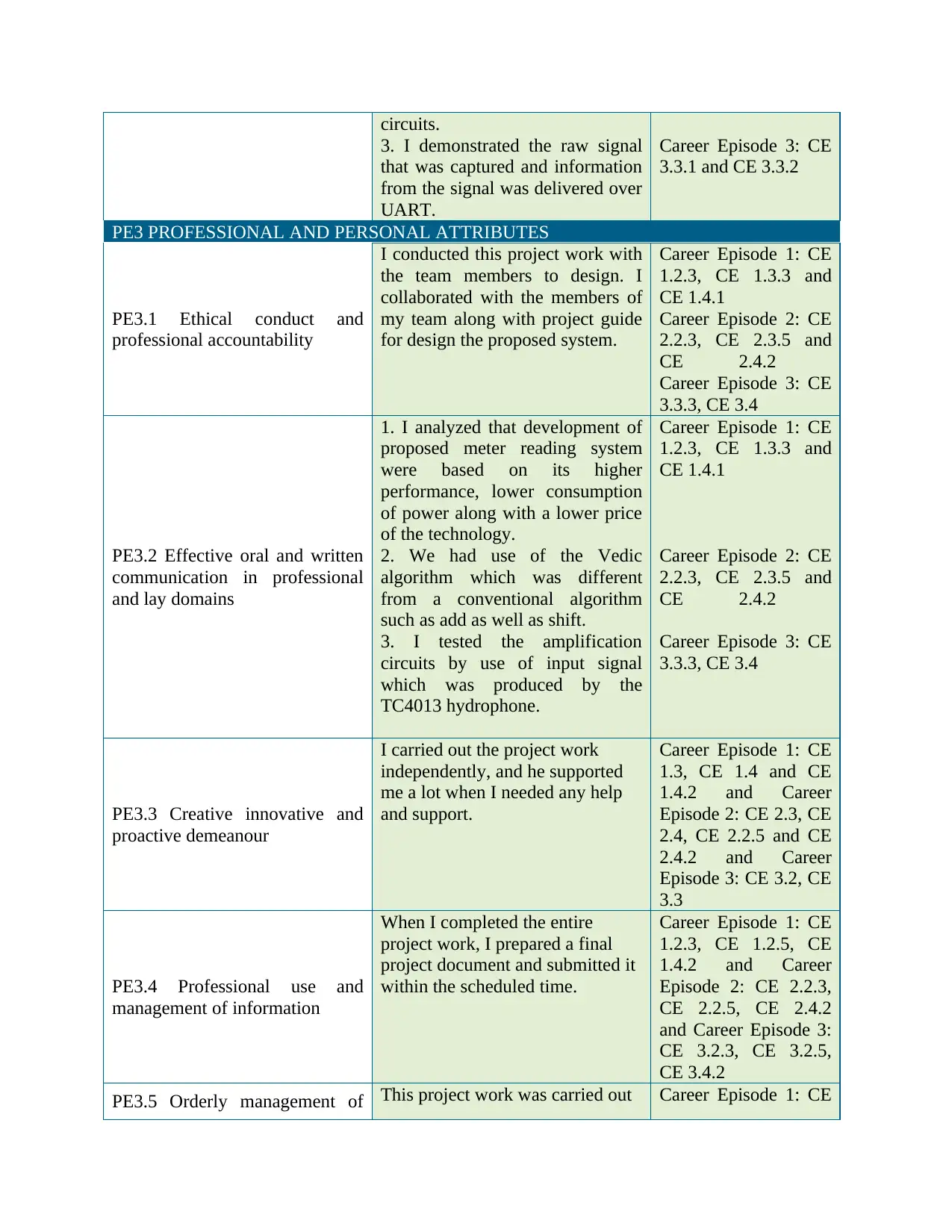
circuits.
3. I demonstrated the raw signal
that was captured and information
from the signal was delivered over
UART.
Career Episode 3: CE
3.3.1 and CE 3.3.2
PE3 PROFESSIONAL AND PERSONAL ATTRIBUTES
PE3.1 Ethical conduct and
professional accountability
I conducted this project work with
the team members to design. I
collaborated with the members of
my team along with project guide
for design the proposed system.
Career Episode 1: CE
1.2.3, CE 1.3.3 and
CE 1.4.1
Career Episode 2: CE
2.2.3, CE 2.3.5 and
CE 2.4.2
Career Episode 3: CE
3.3.3, CE 3.4
PE3.2 Effective oral and written
communication in professional
and lay domains
1. I analyzed that development of
proposed meter reading system
were based on its higher
performance, lower consumption
of power along with a lower price
of the technology.
2. We had use of the Vedic
algorithm which was different
from a conventional algorithm
such as add as well as shift.
3. I tested the amplification
circuits by use of input signal
which was produced by the
TC4013 hydrophone.
Career Episode 1: CE
1.2.3, CE 1.3.3 and
CE 1.4.1
Career Episode 2: CE
2.2.3, CE 2.3.5 and
CE 2.4.2
Career Episode 3: CE
3.3.3, CE 3.4
PE3.3 Creative innovative and
proactive demeanour
I carried out the project work
independently, and he supported
me a lot when I needed any help
and support.
Career Episode 1: CE
1.3, CE 1.4 and CE
1.4.2 and Career
Episode 2: CE 2.3, CE
2.4, CE 2.2.5 and CE
2.4.2 and Career
Episode 3: CE 3.2, CE
3.3
PE3.4 Professional use and
management of information
When I completed the entire
project work, I prepared a final
project document and submitted it
within the scheduled time.
Career Episode 1: CE
1.2.3, CE 1.2.5, CE
1.4.2 and Career
Episode 2: CE 2.2.3,
CE 2.2.5, CE 2.4.2
and Career Episode 3:
CE 3.2.3, CE 3.2.5,
CE 3.4.2
PE3.5 Orderly management of This project work was carried out Career Episode 1: CE
3. I demonstrated the raw signal
that was captured and information
from the signal was delivered over
UART.
Career Episode 3: CE
3.3.1 and CE 3.3.2
PE3 PROFESSIONAL AND PERSONAL ATTRIBUTES
PE3.1 Ethical conduct and
professional accountability
I conducted this project work with
the team members to design. I
collaborated with the members of
my team along with project guide
for design the proposed system.
Career Episode 1: CE
1.2.3, CE 1.3.3 and
CE 1.4.1
Career Episode 2: CE
2.2.3, CE 2.3.5 and
CE 2.4.2
Career Episode 3: CE
3.3.3, CE 3.4
PE3.2 Effective oral and written
communication in professional
and lay domains
1. I analyzed that development of
proposed meter reading system
were based on its higher
performance, lower consumption
of power along with a lower price
of the technology.
2. We had use of the Vedic
algorithm which was different
from a conventional algorithm
such as add as well as shift.
3. I tested the amplification
circuits by use of input signal
which was produced by the
TC4013 hydrophone.
Career Episode 1: CE
1.2.3, CE 1.3.3 and
CE 1.4.1
Career Episode 2: CE
2.2.3, CE 2.3.5 and
CE 2.4.2
Career Episode 3: CE
3.3.3, CE 3.4
PE3.3 Creative innovative and
proactive demeanour
I carried out the project work
independently, and he supported
me a lot when I needed any help
and support.
Career Episode 1: CE
1.3, CE 1.4 and CE
1.4.2 and Career
Episode 2: CE 2.3, CE
2.4, CE 2.2.5 and CE
2.4.2 and Career
Episode 3: CE 3.2, CE
3.3
PE3.4 Professional use and
management of information
When I completed the entire
project work, I prepared a final
project document and submitted it
within the scheduled time.
Career Episode 1: CE
1.2.3, CE 1.2.5, CE
1.4.2 and Career
Episode 2: CE 2.2.3,
CE 2.2.5, CE 2.4.2
and Career Episode 3:
CE 3.2.3, CE 3.2.5,
CE 3.4.2
PE3.5 Orderly management of This project work was carried out Career Episode 1: CE
Secure Best Marks with AI Grader
Need help grading? Try our AI Grader for instant feedback on your assignments.
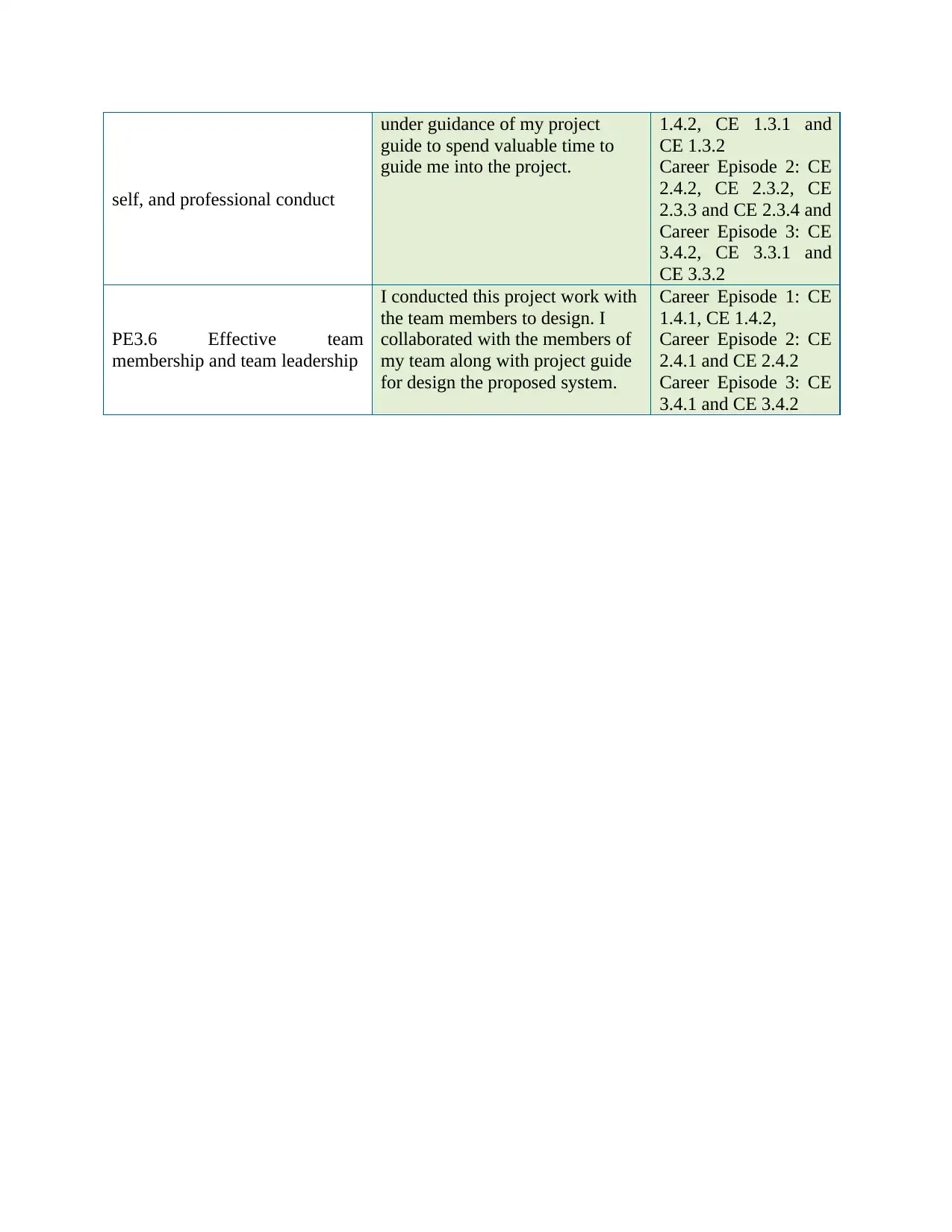
self, and professional conduct
under guidance of my project
guide to spend valuable time to
guide me into the project.
1.4.2, CE 1.3.1 and
CE 1.3.2
Career Episode 2: CE
2.4.2, CE 2.3.2, CE
2.3.3 and CE 2.3.4 and
Career Episode 3: CE
3.4.2, CE 3.3.1 and
CE 3.3.2
PE3.6 Effective team
membership and team leadership
I conducted this project work with
the team members to design. I
collaborated with the members of
my team along with project guide
for design the proposed system.
Career Episode 1: CE
1.4.1, CE 1.4.2,
Career Episode 2: CE
2.4.1 and CE 2.4.2
Career Episode 3: CE
3.4.1 and CE 3.4.2
under guidance of my project
guide to spend valuable time to
guide me into the project.
1.4.2, CE 1.3.1 and
CE 1.3.2
Career Episode 2: CE
2.4.2, CE 2.3.2, CE
2.3.3 and CE 2.3.4 and
Career Episode 3: CE
3.4.2, CE 3.3.1 and
CE 3.3.2
PE3.6 Effective team
membership and team leadership
I conducted this project work with
the team members to design. I
collaborated with the members of
my team along with project guide
for design the proposed system.
Career Episode 1: CE
1.4.1, CE 1.4.2,
Career Episode 2: CE
2.4.1 and CE 2.4.2
Career Episode 3: CE
3.4.1 and CE 3.4.2
1 out of 5
Related Documents
Your All-in-One AI-Powered Toolkit for Academic Success.
+13062052269
info@desklib.com
Available 24*7 on WhatsApp / Email
![[object Object]](/_next/static/media/star-bottom.7253800d.svg)
Unlock your academic potential
© 2024 | Zucol Services PVT LTD | All rights reserved.




